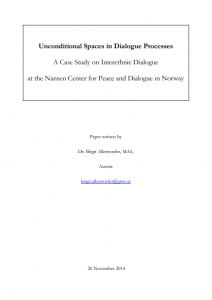 Within this paper, I deepen the understanding of Unconditional Spaces in the context of interethnic dialogue processes. The case study at the Nansen Center for Peace and Dialogue in Lillehammer, Norway, hence provides inspiring insights into the process design of reconciliation efforts on the Western Balkan. While taking part in a one – week dialogue seminar with a group of teachers from Mostar, Bosnia and Herzegovina, I discovered elements of unconditionality in diverse process settings. I identified four main Unconditional Spaces within the seminar structure and perceived the whole dialogue process in Lillehammer as a omprehensive unconditional experience.
Within this paper, I deepen the understanding of Unconditional Spaces in the context of interethnic dialogue processes. The case study at the Nansen Center for Peace and Dialogue in Lillehammer, Norway, hence provides inspiring insights into the process design of reconciliation efforts on the Western Balkan. While taking part in a one – week dialogue seminar with a group of teachers from Mostar, Bosnia and Herzegovina, I discovered elements of unconditionality in diverse process settings. I identified four main Unconditional Spaces within the seminar structure and perceived the whole dialogue process in Lillehammer as a omprehensive unconditional experience.
Throughout this paper, I therefore describe the core qualities, benefits and limitations of these phenomena in peace building. In order to convey a clear picture of Unconditional Spaces in dialogue processes, I call the four categories “ice breaker”, referring to the Olympic ski jump, “new horizon”, talking about an open school, “uniting bond”, pointing at a family dinner, and “laughing smile”, comprising experiences at a fun park. These four seminar components, among others, compliment the core dialogue sessions and support the facilitation effort of creating a protected group spaces. They provide simultaneous experiences of a “safe shelter” and “spirit of freedom” and promote relaxation, emotional openness and visibility. The latter are crucial for sustainable dialogue and reconciliation work, as they constitute the foundation for the ability to relate to oneself and others.
Through participatory observation and personal interviews, I consequently convey diverse perspectives onto the process and from within the seminar group. I highlight the strengths of the Nansen approach and open up the room for further discussions on Unconditional Spaces in peace building initiatives. As unconditionality embraces a variety of forms, I whole – heartedly invite the audience to adapt Unconditional Spaces according to their respective needs.
Case study By Dr. Birgit Allerstorfer
34 pages
Direct download link (PDF, 435 KB)
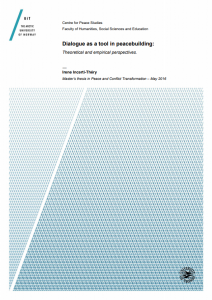 Dialogue is important as humans are in constant communication with one another. As the world currently witnesses violent conflicts on a daily basis, how we respond to conflicting views in communication is an infinitely important matter for human coexistence. We have the possibility to respond with fear, hatred and violence or with open-mindedness, acceptance and understanding. I ask; Is dialogue a peacebuilding tool whose potential has not been exploited? This thesis will discuss dialogue as one form of communication and as a tool in peacebuilding. I take a critical view of the use of dialogue to reach other goals than understanding. I have chosen to collect data from experts on dialogue in Norway and from the United Nations to research the topic of dialogue as a tool in peacebuilding. The research project’s relevance for peace studies is its contribution to literature on dialogue, specifically dialogue in relation to peacebuilding. Further, the study is relevant for peace studies as it addresses how the United Nations work with intercultural and inter-religious dialogue in peacebuilding.
Dialogue is important as humans are in constant communication with one another. As the world currently witnesses violent conflicts on a daily basis, how we respond to conflicting views in communication is an infinitely important matter for human coexistence. We have the possibility to respond with fear, hatred and violence or with open-mindedness, acceptance and understanding. I ask; Is dialogue a peacebuilding tool whose potential has not been exploited? This thesis will discuss dialogue as one form of communication and as a tool in peacebuilding. I take a critical view of the use of dialogue to reach other goals than understanding. I have chosen to collect data from experts on dialogue in Norway and from the United Nations to research the topic of dialogue as a tool in peacebuilding. The research project’s relevance for peace studies is its contribution to literature on dialogue, specifically dialogue in relation to peacebuilding. Further, the study is relevant for peace studies as it addresses how the United Nations work with intercultural and inter-religious dialogue in peacebuilding. In international conflict resolution the term dialogue is used frequently while lacking specificity. When examined in practice, dialogue is revealed as a specific, efficacious method for conflict management and peacebuilding. This article defines dialogue specifically through description of eight characteristics: coexistence; movement; encountering the “other”; assumption; creativity and flexibility; sharing; holistic; and multigenerational. In defining dialogue, a parameter is drawn and a method clarified. The case of Macedonia and the Nansen Dialogue Network (NDN) is drawn upon to illustrate these traits and the success of the method in long‐term conflict management and peacebuilding. NDN has used its dialogic approach in Macedonia, leading to integrated schooling. As integrated schooling has continued success with NDN as an ongoing dialogue facilitator, as of 2011 the Macedonia government is considering it as an educational model. As evidence of further success, this dialogue work has led to continued funding as well as peace‐related awards and nominations to NDN. Understanding the nature and success of dialogue as practiced is an essential, though often overlooked, aspect of international relations work.
In international conflict resolution the term dialogue is used frequently while lacking specificity. When examined in practice, dialogue is revealed as a specific, efficacious method for conflict management and peacebuilding. This article defines dialogue specifically through description of eight characteristics: coexistence; movement; encountering the “other”; assumption; creativity and flexibility; sharing; holistic; and multigenerational. In defining dialogue, a parameter is drawn and a method clarified. The case of Macedonia and the Nansen Dialogue Network (NDN) is drawn upon to illustrate these traits and the success of the method in long‐term conflict management and peacebuilding. NDN has used its dialogic approach in Macedonia, leading to integrated schooling. As integrated schooling has continued success with NDN as an ongoing dialogue facilitator, as of 2011 the Macedonia government is considering it as an educational model. As evidence of further success, this dialogue work has led to continued funding as well as peace‐related awards and nominations to NDN. Understanding the nature and success of dialogue as practiced is an essential, though often overlooked, aspect of international relations work.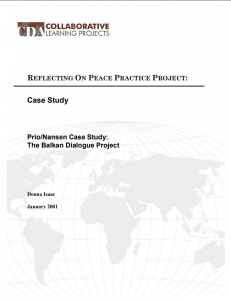 This case study will examine the Balkan Dialogue Project that is actually two integrated projects. The initial project of Democracy, Human Rights, and Peaceful Conflict Resolution began in 1995 with training at the Nansen Academy in Lillehammer, Norway. The Nansen Dialogue project is a pedagogical concept and served as the starting point for the later Balkan Dialogue Project. The Balkan Dialogue Project began in 1999. It is an activity that evolved from the educational premise of the earlier project. In this paper, the two projects are viewed as one integrated process and the earlier distinction thus has become irrelevant. The Balkan Dialogue Project is discussed from its earliest history, then the case study examines the roles of the cooperating partners that are both governmental and nongovernmental agencies and finally the participants’ views of the process. From this perspective, the case study looks at how the participants are taking the dialogue process back to their respective regions and the impact of this local dialogue building.
This case study will examine the Balkan Dialogue Project that is actually two integrated projects. The initial project of Democracy, Human Rights, and Peaceful Conflict Resolution began in 1995 with training at the Nansen Academy in Lillehammer, Norway. The Nansen Dialogue project is a pedagogical concept and served as the starting point for the later Balkan Dialogue Project. The Balkan Dialogue Project began in 1999. It is an activity that evolved from the educational premise of the earlier project. In this paper, the two projects are viewed as one integrated process and the earlier distinction thus has become irrelevant. The Balkan Dialogue Project is discussed from its earliest history, then the case study examines the roles of the cooperating partners that are both governmental and nongovernmental agencies and finally the participants’ views of the process. From this perspective, the case study looks at how the participants are taking the dialogue process back to their respective regions and the impact of this local dialogue building. Since the end of the war in the 1990s Bosnia and Herzegovina (BiH) has been considered a deeply ethnically divided society, where ethnicity determines almost all aspects of life: cultural, social, political, and economical. This chapter reflects on the experience of the Nansen Dialogue Center in Sarajevo (NDC Sarajevo) and its mission to promote interethnic dialogue and to create interethnic initiatives among ethnically divided communities in BiH. In particular, the roles of parents, teachers, students, principals, and politicians in the initiatives for integrated education are examined.
Since the end of the war in the 1990s Bosnia and Herzegovina (BiH) has been considered a deeply ethnically divided society, where ethnicity determines almost all aspects of life: cultural, social, political, and economical. This chapter reflects on the experience of the Nansen Dialogue Center in Sarajevo (NDC Sarajevo) and its mission to promote interethnic dialogue and to create interethnic initiatives among ethnically divided communities in BiH. In particular, the roles of parents, teachers, students, principals, and politicians in the initiatives for integrated education are examined.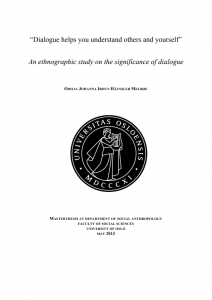 Through this empirical study on the significance of dialogue, this thesis aims to fill a knowledge gap in dialogical anthropology, contributing with a processual and relational perspective on how to understand dialogue. I have conducted seven months of fieldwork among participants and employees at Nansen Center for Peace and Dialogue, in Lillehammer, Norway, and have taken part in seminars where dialogue is significant as concept and practice. The interlocutors in this study have background from Afghanistan, Iraqi Kurdistan, Bosnia-Herzegovina, Serbia, Croatia, Macedonia, Kosovo, United States, some living in these respective countries and some in Norway. Most of the interlocutors have experiences with conflict, and come to the seminars to learn about dialogue techniques, meet people from different sides in a conflict, and to build cooperation between participants, both in diaspora groups in Norway and in their country of origin.
Through this empirical study on the significance of dialogue, this thesis aims to fill a knowledge gap in dialogical anthropology, contributing with a processual and relational perspective on how to understand dialogue. I have conducted seven months of fieldwork among participants and employees at Nansen Center for Peace and Dialogue, in Lillehammer, Norway, and have taken part in seminars where dialogue is significant as concept and practice. The interlocutors in this study have background from Afghanistan, Iraqi Kurdistan, Bosnia-Herzegovina, Serbia, Croatia, Macedonia, Kosovo, United States, some living in these respective countries and some in Norway. Most of the interlocutors have experiences with conflict, and come to the seminars to learn about dialogue techniques, meet people from different sides in a conflict, and to build cooperation between participants, both in diaspora groups in Norway and in their country of origin.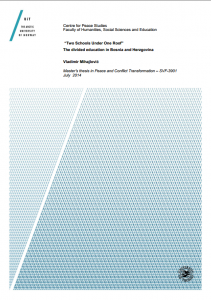 Bosnia and Herzegovina is a multi-ethnic society with three ethnic groups (Bosniaks, Serbs and Croats) comprising a vast majority of the population. The dissolution of Yugoslavia found these three ethnic groups at war with one another, a war that lasted 4 years and claimed around 100 000 lives. The war ended with the peace agreement in Dayton, 1995 that officially established two territorial entities within the country, the Serb Republic and the Federation of Bosnia and Herzegovina (with Bosniaks and Croats comprising most of the population). As opposed to the period before the war, the country was completely split along ethnic lines. The educational system was also divided with different content and curriculums for each ethnic group in what is known as the national group of subjects. History in particular is taught differently to students of different ethnic groups. My goals is to showcase these differences and discuss their possible impact on the young citizens of Bosnia and Herzegovina, establish whether hey perpetuate the existing rifts and tensions or contributes to a more tolerant view of other ethnic groups. I am also intrigued by cases of having students of different ethnic groups sharing the same school premises, yet attending all classes separately. Such cases came to be known as ‘Two Schools under the same roof’. Symbolically, ‘the same roof’ can also refer to the state of Bosnia and Herzegovina and its numerous students of different background learning different truths about their country and historical events that shaped its narrative.
Bosnia and Herzegovina is a multi-ethnic society with three ethnic groups (Bosniaks, Serbs and Croats) comprising a vast majority of the population. The dissolution of Yugoslavia found these three ethnic groups at war with one another, a war that lasted 4 years and claimed around 100 000 lives. The war ended with the peace agreement in Dayton, 1995 that officially established two territorial entities within the country, the Serb Republic and the Federation of Bosnia and Herzegovina (with Bosniaks and Croats comprising most of the population). As opposed to the period before the war, the country was completely split along ethnic lines. The educational system was also divided with different content and curriculums for each ethnic group in what is known as the national group of subjects. History in particular is taught differently to students of different ethnic groups. My goals is to showcase these differences and discuss their possible impact on the young citizens of Bosnia and Herzegovina, establish whether hey perpetuate the existing rifts and tensions or contributes to a more tolerant view of other ethnic groups. I am also intrigued by cases of having students of different ethnic groups sharing the same school premises, yet attending all classes separately. Such cases came to be known as ‘Two Schools under the same roof’. Symbolically, ‘the same roof’ can also refer to the state of Bosnia and Herzegovina and its numerous students of different background learning different truths about their country and historical events that shaped its narrative.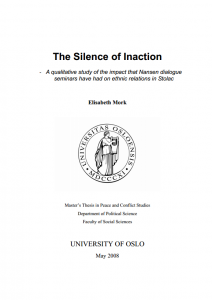 The primary aim of this thesis is to investigate if the dialogue seminars organised by the Nansen Dialogue Centre (NDC) in Mostar have had a perceptible impact on ethnic relations locally in Stolac, at the level of practices and/or representations – and if so, in which ways. The main method used for generating empirical data was qualitative analysis of interviews with four teachers who work at the ethnically segregated Stolac High School. The empirical data from the interviews with the teachers were compared with data from interviews with two participants from Srebenica. The findings indicate that the dialogue seminars have created a limited sphere for inter-ethnic interaction for the teachers in Stolac. In the seminars they were able to share common goals and needs, and work on joint problems regarding Stolac High School. However, the seminars do not seem to have had a significant impact at the level of practices. There is a relative absence of newly initiated inter-ethnic social relationships involving the participants from Stolac taking part in the dialogue seminars. The teachers have not had much further contact with one another without help from the NDC, even though they all argue that this contact is highly appreciated and needed. Some interpretations for the teachers’ apparent reluctance to initiate contact with “the other” participants are addressed in this thesis.
The primary aim of this thesis is to investigate if the dialogue seminars organised by the Nansen Dialogue Centre (NDC) in Mostar have had a perceptible impact on ethnic relations locally in Stolac, at the level of practices and/or representations – and if so, in which ways. The main method used for generating empirical data was qualitative analysis of interviews with four teachers who work at the ethnically segregated Stolac High School. The empirical data from the interviews with the teachers were compared with data from interviews with two participants from Srebenica. The findings indicate that the dialogue seminars have created a limited sphere for inter-ethnic interaction for the teachers in Stolac. In the seminars they were able to share common goals and needs, and work on joint problems regarding Stolac High School. However, the seminars do not seem to have had a significant impact at the level of practices. There is a relative absence of newly initiated inter-ethnic social relationships involving the participants from Stolac taking part in the dialogue seminars. The teachers have not had much further contact with one another without help from the NDC, even though they all argue that this contact is highly appreciated and needed. Some interpretations for the teachers’ apparent reluctance to initiate contact with “the other” participants are addressed in this thesis.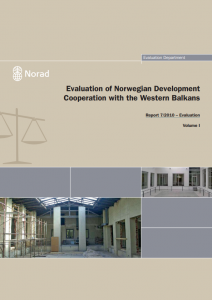 This report presents the findings of an evaluation of a large portion of Norwegian development cooperation that has not previously been systematically evaluated. During the period 1991-2008 the Norwegian aid to the Western Balkans amounted to about ten billion Norwegian kroner. The decision by our Department to carry out this evaluation was based partly on the Norwegian Government’s criterion for evaluation of importance and size, partly on the criterion of uniqueness, in the sense that the object of the evaluation has been development aid to European countries.
This report presents the findings of an evaluation of a large portion of Norwegian development cooperation that has not previously been systematically evaluated. During the period 1991-2008 the Norwegian aid to the Western Balkans amounted to about ten billion Norwegian kroner. The decision by our Department to carry out this evaluation was based partly on the Norwegian Government’s criterion for evaluation of importance and size, partly on the criterion of uniqueness, in the sense that the object of the evaluation has been development aid to European countries.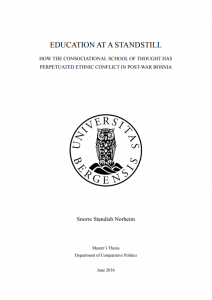 This study set out to explore why the consociational prescription to have cultural autonomy in education contributes to perpetuating ethnic conflict instead of conflict resolving, in post-war societies like Bosnia and Herzegovina. The prescription is to recognise and strengthen the major ethnic groups through decentralisation of decision-making in education. The study analyses a fragmented and politicised educational system, and its consequences for inter-ethnic relations, which are analysed and presented as manifestations of exclusivist, educational protectionism. The single-case study on consociational post-war Bosnia and Herzegovina builds on interview data from a three-week-long fieldwork in Mostar and Sarajevo, in January 2016.
This study set out to explore why the consociational prescription to have cultural autonomy in education contributes to perpetuating ethnic conflict instead of conflict resolving, in post-war societies like Bosnia and Herzegovina. The prescription is to recognise and strengthen the major ethnic groups through decentralisation of decision-making in education. The study analyses a fragmented and politicised educational system, and its consequences for inter-ethnic relations, which are analysed and presented as manifestations of exclusivist, educational protectionism. The single-case study on consociational post-war Bosnia and Herzegovina builds on interview data from a three-week-long fieldwork in Mostar and Sarajevo, in January 2016.